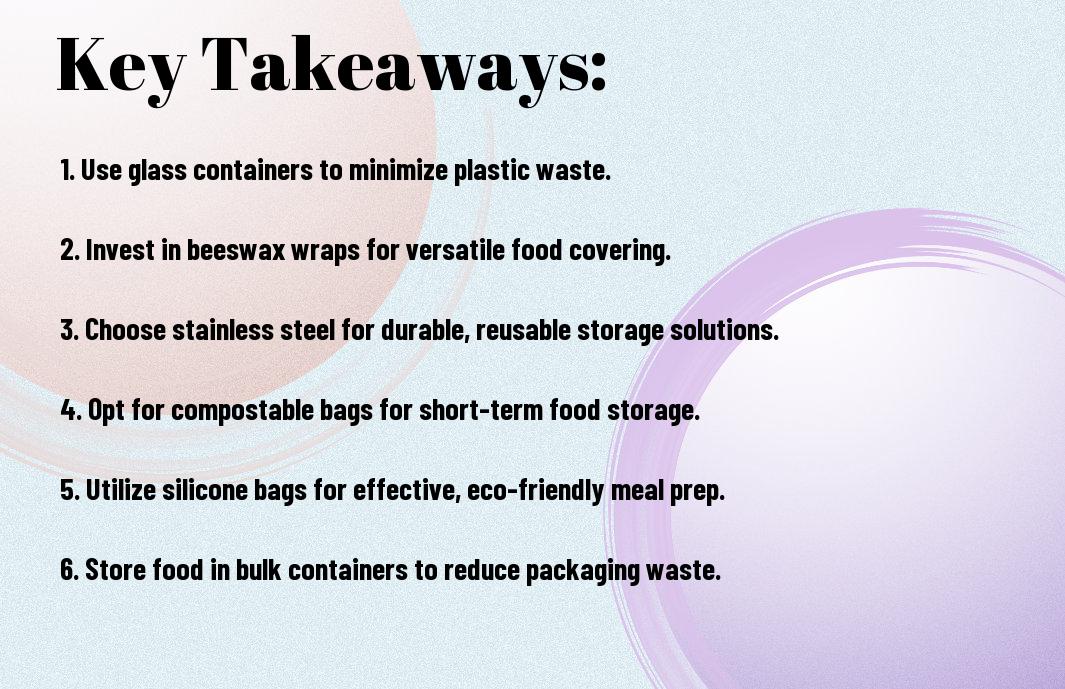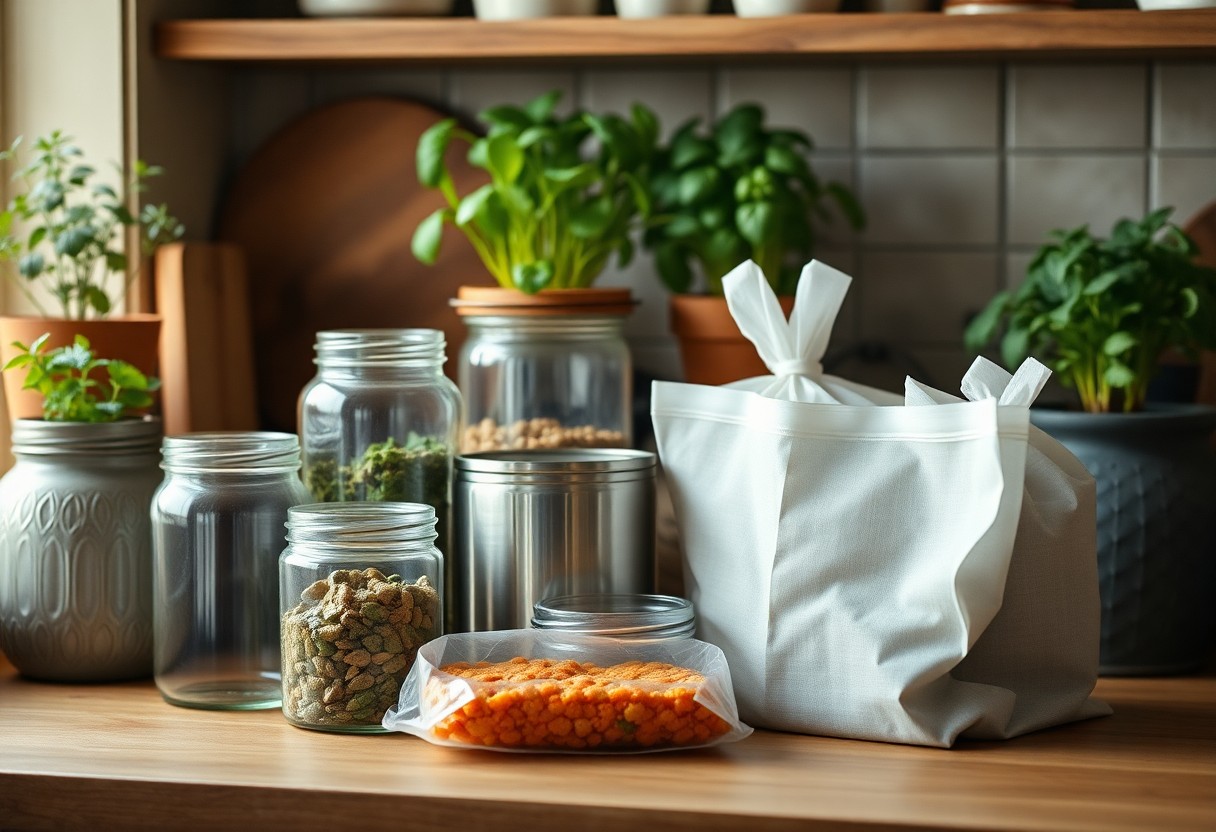As you strive to reduce your environmental footprint, one area to focus on is your kitchen. You can start by exploring sustainable food storage options that help keep your food fresh while minimizing waste. When looking for the best containers for your needs, you can check out The Best Food Storage Containers for Leftovers, Meal Prep, and More to find the perfect fit for your home, allowing you to store food safely and sustainably.
Key Takeaways:
To reduce our environmental footprint, it’s vital to adopt sustainable practices in every aspect of our lives, including food storage. Here are the main points to consider:
- Using reusable containers is an excellent way to store food, as they can be used multiple times, reducing the need for single-use plastics and minimizing waste.
- Eco-friendly storage solutions like beeswax wraps, glass containers, and stainless steel containers are great alternatives to traditional plastic storage options.
- Investing in a root cellar or a cold storage unit can help keep fruits and vegetables fresh for longer, reducing the need for energy-intensive refrigeration and preserving the quality of the food.
- Implementing proper food storage techniques, such as cooling, freezing, and dehydrating, can help extend the shelf life of perishable items and reduce food waste.
- Choosing locally sourced and seasonal produce can also contribute to a more sustainable food system, as it reduces the need for long-distance transportation and supports the local economy.
Assessing Food Storage Needs
A thorough assessment of your food storage needs is necessary to create an effective storage system. You need to consider your eating habits, the type of food you store, and the space available in your kitchen.
Evaluating Kitchen Space
At the outset, take stock of your kitchen’s layout and dimensions to determine the best storage solutions for your space. You should measure your shelves, cabinets, and countertops to decide what size storage containers you can accommodate.
Considering Dietary Requirements
Any dietary restrictions or preferences you or your family members have will significantly impact your food storage needs. You should think about the types of food you need to store, such as gluten-free, vegan, or kosher options, and plan your storage accordingly.
Even if you have specific dietary needs, you can still find suitable storage solutions. You can label your storage containers to keep track of different types of food, and consider using separate storage areas for specialty items to avoid cross-contamination and ensure easy access to the food you need.

Sustainable Storage Solutions
There’s no denying that sustainable storage solutions are important for reducing your environmental footprint. You can make a significant impact by incorporating eco-friendly storage options into your daily life, starting with your kitchen. By choosing sustainable storage solutions, you can help minimize waste and keep your food fresh for longer.
Reusable Containers
Prior to switching to disposable containers, you likely used reusable ones without giving it a second thought. You can use glass or stainless steel containers to store your food, which are durable and can be used multiple times, reducing your reliance on single-use plastics.
Eco-Friendly Wraps
For a more sustainable alternative to plastic wrap, you can use eco-friendly wraps made from natural materials like beeswax or cloth. You can use these wraps to cover bowls, wrap snacks, and even store leftovers, reducing your use of plastic wrap and aluminum foil.
Consequently, as you explore the world of eco-friendly wraps, you’ll find that they are not only better for the environment, but also a healthier option for you and your family. You can wash and reuse these wraps multiple times, making them a valuable addition to your sustainable storage solutions. By incorporating eco-friendly wraps into your daily routine, you can significantly reduce your waste and create a more sustainable kitchen.
Food Preservation Methods
Despite the varying techniques, you can find a preservation method that suits your needs, allowing you to enjoy your favorite foods year-round while reducing food waste and supporting sustainable living.
Canning and Pickling
Methods like canning and pickling are great ways to preserve food, enabling you to store your harvest for extended periods, and they can be a fun and rewarding process for you to try in your own home.
Freezing and Dehydrating
Comparable to canning, freezing and dehydrating are excellent alternatives for preserving food, offering you a way to keep your food fresh for a longer period and maintain its nutritional value.
It is imperative to note that freezing and dehydrating require proper techniques and equipment to ensure your food is safely preserved, and you can find various resources online to guide you through the process, helping you to make the most of your harvest and reduce food waste in your home.
Kitchen Organization Tips
Keep your kitchen organized with simple tips. Consider:
- Assigning a home for each item
- Utilizing vertical space
Perceiving your kitchen as a cohesive unit will help you maintain organization.
Maximizing Pantry Space
Pertaining to your pantry, prioritize items by frequency of use. You can optimize storage by installing shelves or baskets, making the most of your pantry’s potential.
Labeling and Inventory
Among the most effective ways to maintain your kitchen, labeling and inventory management stand out. You can use labels and lists to keep track of your stored food, ensuring you use items before they expire.
At the heart of effective labeling and inventory management is a system that works for you. You can use a spreadsheet or a mobile app to track your stored food, noting expiration dates and quantities. By doing so, you’ll be able to plan meals, avoid waste, and make the most of your kitchen storage, ensuring your food stays fresh and your kitchen stays organized.

Healthy Eating and Food Storage
All aspects of your life are impacted by the food you eat, and storing it properly is necessary for maintaining its nutritional value. You can keep your food fresh and healthy by using the right storage methods and containers.
Nutritious Food Choices
Choosing healthy options is key to maintaining a balanced diet, and you should consider the storage needs of different foods when planning your meals. You can make informed decisions about your food storage based on the types of food you buy and cook.
Avoiding Food Waste
Food preservation is an necessary part of sustainable living, and you can reduce waste by storing your food effectively. You can keep track of your food’s shelf life and plan your meals accordingly to minimize waste.
Plus, by being mindful of your food storage, you can also save money and reduce your environmental impact. You can use containers that are designed to keep food fresh for longer, and label them so you can easily identify what you have stored and how long it has been there, helping you to use up ingredients before they expire.
Creative Storage Ideas
Your home can become a model of sustainability with creative food storage solutions, allowing you to reduce waste and keep your kitchen organized.
Repurposing Old Containers
Along with reducing waste, you can breathe new life into old containers by repurposing them as storage for dry goods, spices, or leftovers, making your kitchen more efficient.
DIY Storage Projects
Between the options of buying or building, you can create your own storage solutions using materials like wood, bamboo, or reclaimed items, giving your kitchen a unique touch.
To take your DIY storage projects to the next level, you can consider adding labels, compartments, or shelves to maximize space and make the most out of your creations, ensuring that your food storage is both functional and aesthetically pleasing, making you feel proud of your sustainable kitchen setup.
Conclusion
Conclusively, you now have various sustainable food storage options to explore for your home. You can choose from glass containers, beeswax wraps, or bamboo storage bins to reduce your environmental footprint. By implementing these solutions, you will not only reduce waste but also keep your food fresh for a longer period, ultimately saving your time and money. Your decision to adopt sustainable food storage will contribute to a healthier planet.
FAQ
Q: What are the benefits of using glass containers for food storage?
A: Glass containers are an excellent sustainable food storage option for every home. They are non-toxic, non-porous, and can be used for both hot and cold foods. Glass containers also preserve the flavor and aroma of food, and are 100% recyclable. Additionally, they are durable and can be used for a long time, reducing the need for single-use plastic containers and minimizing waste.
Q: How can I use beeswax wraps as a sustainable alternative to plastic wrap?
A: Beeswax wraps are a natural, reusable, and biodegradable alternative to plastic wrap. To use them, simply wrap your food or container with the beeswax wrap, and the heat from your hands will help to mold the wrap to create a seal. Beeswax wraps can be used to store a variety of foods, including fruits, vegetables, cheese, and bread. They are also easy to clean and maintain, and can be reused multiple times, making them a great sustainable food storage option for every home.
Q: What are some tips for maintaining and cleaning sustainable food storage containers?
A: To maintain and clean sustainable food storage containers, such as glass or stainless steel containers, or beeswax wraps, it’s necessary to wash them regularly with soap and warm water. For glass and stainless steel containers, a gentle scrubber or soft cloth can be used to remove any stubborn stains or residue. For beeswax wraps, a mild soap and cold water should be used to avoid damaging the wax. Additionally, it’s a good idea to dry your containers and wraps thoroughly after washing to prevent moisture from accumulating and causing bacterial growth. By following these simple tips, you can help extend the life of your sustainable food storage containers and keep them in good condition for a long time.
